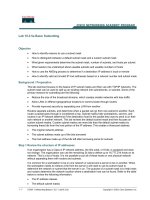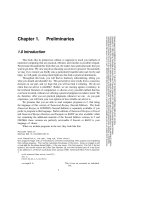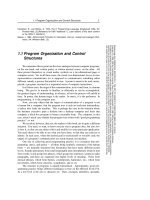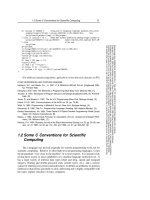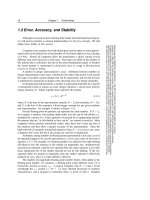Tài liệu Preliminaries part 3 docx
Bạn đang xem bản rút gọn của tài liệu. Xem và tải ngay bản đầy đủ của tài liệu tại đây (164.69 KB, 14 trang )
1.2 Some C Conventions for Scientific Computing
15
Sample page from NUMERICAL RECIPES IN C: THE ART OF SCIENTIFIC COMPUTING (ISBN 0-521-43108-5)
Copyright (C) 1988-1992 by Cambridge University Press.Programs Copyright (C) 1988-1992 by Numerical Recipes Software.
Permission is granted for internet users to make one paper copy for their own personal use. Further reproduction, or any copying of machine-
readable files (including this one) to any servercomputer, is strictly prohibited. To order Numerical Recipes books,diskettes, or CDROMs
visit website or call 1-800-872-7423 (North America only),or send email to (outside North America).
if (julian >= IGREG) { Cross-over to Gregorian Calendar produces this correc-
tion.jalpha=(long)(((float) (julian-1867216)-0.25)/36524.25);
ja=julian+1+jalpha-(long) (0.25*jalpha);
} else if (julian < 0) { Make day number positive by adding integer number of
Julian centuries, then subtract them off
at the end.
ja=julian+36525*(1-julian/36525);
} else
ja=julian;
jb=ja+1524;
jc=(long)(6680.0+((float) (jb-2439870)-122.1)/365.25);
jd=(long)(365*jc+(0.25*jc));
je=(long)((jb-jd)/30.6001);
*id=jb-jd-(long) (30.6001*je);
*mm=je-1;
if (*mm > 12) *mm -= 12;
*iyyy=jc-4715;
if (*mm > 2) --(*iyyy);
if (*iyyy <= 0) --(*iyyy);
if (julian < 0) iyyy -= 100*(1-julian/36525);
}
(Foradditionalcalendricalalgorithms, applicableto various historical calendars,see
[8]
.)
CITED REFERENCES AND FURTHER READING:
Harbison, S.P., and Steele, G.L., Jr. 1991,
C: A Reference Manual
, 3rd ed. (Englewood Cliffs,
NJ: Prentice-Hall).
Kernighan, B.W. 1978,
The Elements of Programming Style
(New York: McGraw-Hill). [1]
Yourdon, E. 1975,
Techniques of Program Structure and Design
(Englewood Cliffs, NJ: Prentice-
Hall). [2]
Jones, R., and Stewart, I. 1987,
The Art of C Programming
(New York: Springer-Verlag). [3]
Hoare, C.A.R. 1981,
Communications of the ACM
, vol. 24, pp. 75–83.
Wirth, N. 1983,
Programming in Modula-2
, 3rd ed. (New York: Springer-Verlag). [4]
Stroustrup, B. 1986,
The C++ Programming Language
(Reading, MA: Addison-Wesley). [5]
Borland International, Inc. 1989,
Turbo Pascal 5.5 Object-Oriented Programming Guide
(Scotts
Valley, CA: Borland International). [6]
Meeus, J. 1982,
Astronomical Formulae for Calculators
, 2nd ed., revised and enlarged (Rich-
mond, VA: Willmann-Bell). [7]
Hatcher, D.A. 1984,
Quarterly Journal of the Royal Astronomical Society
, vol. 25, pp. 53–55; see
also
op. cit.
1985, vol. 26, pp. 151–155, and 1986, vol. 27, pp. 506–507. [8]
1.2 Some C Conventions for Scientific
Computing
The C language was devised originally for systems programming work, not for
scientific computing. Relative to other high-level programming languages, C puts
the programmer “very close to the machine” in several respects. It is operator-rich,
giving direct access to most capabilities of a machine-language instruction set. It
has a large variety of intrinsic data types (short and long, signed and unsigned
integers; floating and double-precision reals; pointer types; etc.), and a concise
syntax for effecting conversions and indirections. It defines an arithmetic on pointers
(addresses) that relates gracefully to array addressing and is highly compatible with
the index register structure of many computers.
16
Chapter 1. Preliminaries
Sample page from NUMERICAL RECIPES IN C: THE ART OF SCIENTIFIC COMPUTING (ISBN 0-521-43108-5)
Copyright (C) 1988-1992 by Cambridge University Press.Programs Copyright (C) 1988-1992 by Numerical Recipes Software.
Permission is granted for internet users to make one paper copy for their own personal use. Further reproduction, or any copying of machine-
readable files (including this one) to any servercomputer, is strictly prohibited. To order Numerical Recipes books,diskettes, or CDROMs
visit website or call 1-800-872-7423 (North America only),or send email to (outside North America).
Portability has always been another strong point of the C language. C is the
underlying language of the UNIX operating system; both the language and the
operating system have by now been implemented on literally hundreds of different
computers. The language’s universality, portability, and flexibility have attracted
increasing numbers of scientists and engineers to it. It is commonly used for the
real-time controlof experimental hardware, often in spite of the fact that the standard
UNIX kernel is less than ideal as an operating system for this purpose.
The use of C for higher level scientific calculations such as data analysis,
modeling,andfloating-pointnumericalworkhasgenerallybeen slowerindeveloping.
In part this is due to the entrenched position of FORTRAN as the mother-tongue of
virtually all scientists and engineers born before 1960, and most born after. In
part, also, the slowness of C’s penetration into scientific computing has been due to
deficiencies in the language that computer scientists have been (we think,stubbornly)
slow to recognize. Examples are the lack of a good way to raise numbers to small
integer powers, and the “implicit conversion of float to double” issue, discussed
below. Many, though not all, of these deficiencies are overcome in the ANSI C
Standard. Some remaining deficiencies will undoubtedly disappear over time.
Yet another inhibitionto the mass conversion of scientists to the C cult has been,
up to the time of writing, the decided lack of high-quality scientific or numerical
libraries. That is the lacuna into which we thrust this edition of Numerical Recipes.
We certainly do not claim to be a complete solution to the problem. We do hope
to inspire further efforts, and to lay out by example a set of sensible, practical
conventions for scientific C programming.
The need for programming conventions in C is very great. Far from the problem
of overcoming constraints imposed by the language (our repeated experience with
Pascal), the problem in C is to choose the best and most natural techniques from
multiple opportunities — and then to use those techniques completely consistently
from program to program. In the rest of this section, we set out some of the issues,
and describe the adopted conventions that are used in all of the routines in this book.
Function Prototypes and Header Files
ANSI C allows functions to be defined with function prototypes, which specify
the type of each function parameter. If a function declaration or definition with
a prototype is visible, the compiler can check that a given function call invokes
the function with the correct argument types. All the routines printed in this book
are in ANSI C prototype form. For the benefit of readers with older “traditional
K&R” C compilers, the Numerical Recipes C Diskette includes two complete sets of
programs, one in ANSI, the other in K&R.
The easiest way to understand prototypes is by example. A function definition
that would be written in traditional C as
int g(x,y,z)
int x,y;
float z;
becomes in ANSI C
1.2 Some C Conventions for Scientific Computing
17
Sample page from NUMERICAL RECIPES IN C: THE ART OF SCIENTIFIC COMPUTING (ISBN 0-521-43108-5)
Copyright (C) 1988-1992 by Cambridge University Press.Programs Copyright (C) 1988-1992 by Numerical Recipes Software.
Permission is granted for internet users to make one paper copy for their own personal use. Further reproduction, or any copying of machine-
readable files (including this one) to any servercomputer, is strictly prohibited. To order Numerical Recipes books,diskettes, or CDROMs
visit website or call 1-800-872-7423 (North America only),or send email to (outside North America).
int g(int x, int y, float z)
A function that has no parameters has the parameter type list void.
A function declaration (as contrasted to a function definition) is used to
“introduce” a function to a routine that is going to call it. The calling routine needs
to know the number and type of arguments and the type of the returned value. In
a function declaration, you are allowed to omit the parameter names. Thus the
declaration for the above function is allowed to be written
int g(int, int, float);
If a C program consists of multiple source files, the compiler cannot check the
consistency of each function call without some additional assistance. The safest
way to proceed is as follows:
• Every external function should have a single prototype declaration in a
header (.h)file.
•The source file with the definition (body) of the function should also
include the header file so that the compiler can check that the prototypes
in the declaration and the definition match.
• Every source file that calls the function should include the appropriate
header (.h)file.
•Optionally, a routine that calls a function can also include that function’s
prototype declaration internally. This is often useful when you are
developing a program, since it gives you a visible reminder (checked by
the compiler through the common .h file) of a function’s argument types.
Later, after your program is debugged, you can go back and delete the
supernumary internal declarations.
For the routines in this book, the header file containing all the prototypes is nr.h,
listed in Appendix A. You should put the statement #include nr.h at the top of
every source file that contains Numerical Recipes routines. Since, more frequently
than not, you will want to include more than one Numerical Recipes routine in a
single source file, we have not printed this #include statement in front of this
book’s individual program listings, but you should make sure that it is present in
your programs.
As backup, and in accordance with the last item on the indented list above, we
declare the function prototype of all Numerical Recipes routines that are called by
other Numerical Recipes routines internally to the calling routine. (That also makes
our routines much more readable.) The only exception to this rule is that the small
number of utility routines that we use repeatedly (described below) are declared in
the additional header file nrutil.h, and the line #include nrutil.h is explicitly
printed whenever it is needed.
A final important point about the header file nr.h is that, as furnished on
the diskette, it contains both ANSI C and traditional K&R-style declarations. The
ANSI forms are invoked if any of the following macros are defined: __STDC__,
ANSI,orNRANSI. (The purpose of the last name is to give you an invocation that
does not conflict with other possible uses of the first two names.) If you have an
ANSI compiler, it is essential that you invoke it with one or more of these macros
18
Chapter 1. Preliminaries
Sample page from NUMERICAL RECIPES IN C: THE ART OF SCIENTIFIC COMPUTING (ISBN 0-521-43108-5)
Copyright (C) 1988-1992 by Cambridge University Press.Programs Copyright (C) 1988-1992 by Numerical Recipes Software.
Permission is granted for internet users to make one paper copy for their own personal use. Further reproduction, or any copying of machine-
readable files (including this one) to any servercomputer, is strictly prohibited. To order Numerical Recipes books,diskettes, or CDROMs
visit website or call 1-800-872-7423 (North America only),or send email to (outside North America).
defined. The typical means for doing so is to include a switch like “-DANSI”on
the compiler command line.
Some further details about the file nr.h are given in Appendix A.
Vectors and One-Dimensional Arrays
There is a close, and elegant, correspondence in C between pointers and arrays.
The value referenced by an expression like a[j] is defined to be *((a)+(j)),
that is, “the contents of the address obtained by incrementing the pointer a by
j.” A consequence of this definition is that if a points to a legal data location,
the array element a[0] is always defined. Arrays in C are natively “zero-origin”
or “zero-offset.” An array declared by the statement float b[4]; has the valid
references b[0], b[1], b[2],andb[3], but not b[4].
Right away we need a notation to indicate what is the valid range of an array
index. (The issue comes up about a thousand times in this book!) For the above
example, the index range of b will be henceforth denoted b[0..3], a notation
borrowed from Pascal. In general, the range of an array declared by float
a[M]; is a[0..M − 1],andthesameiffloat is replaced by any other data type.
One problem is that many algorithms naturally like to go from 1 to M, not
from 0 to M − 1. Sure, you can always convert them, but they then often acquire
a baggage of additional arithmetic in array indices that is, at best, distracting. It is
better to use the power of the C language, in a consistent way, to make the problem
disappear. Consider
float b[4],*bb;
bb=b-1;
The pointer bb now points one location before b. An immediate consequence is that
the array elements bb[1], bb[2], bb[3],andbb[4] all exist. In other words the
range of bb is bb[1..4]. We will refer to bb as a unit-offset vector. (See Appendix
B for some additional discussion of technical details.)
It is sometimes convenient to use zero-offset vectors, and sometimes convenient
to use unit-offset vectors in algorithms. The choice should be whichever is most
natural to the problem at hand. For example, the coefficients of a polynomial
a
0
+ a
1
x + a
2
x
2
+ ...+ a
n
x
n
clearly cry out for the zero-offset a[0..n], while
a vector of N data points x
i
,i=1...N calls for a unit-offset x[1..N].Whena
routine in this book has an array as an argument, its header comment always gives
the expected index range. For example,
void someroutine(float bb[], int nn)
This routine does something with the vector bb[1..nn].
...
Now, suppose you want someroutine() to do its thing on your own vector,
of length 7, say. If your vector, call it aa, is already unit-offset (has the valid range
aa[1..7]), then you can invoke someroutine(aa,7);in the obvious way. That is
the recommended procedure, since someroutine() presumably has some logical,
or at least aesthetic, reason for wanting a unit-offset vector.
1.2 Some C Conventions for Scientific Computing
19
Sample page from NUMERICAL RECIPES IN C: THE ART OF SCIENTIFIC COMPUTING (ISBN 0-521-43108-5)
Copyright (C) 1988-1992 by Cambridge University Press.Programs Copyright (C) 1988-1992 by Numerical Recipes Software.
Permission is granted for internet users to make one paper copy for their own personal use. Further reproduction, or any copying of machine-
readable files (including this one) to any servercomputer, is strictly prohibited. To order Numerical Recipes books,diskettes, or CDROMs
visit website or call 1-800-872-7423 (North America only),or send email to (outside North America).
But suppose that your vector of length 7, now call it a, is perversely a native C,
zero-offset array (has range a[0..6]). Perhaps this is the case because you disagree
with our aesthetic prejudices, Heaven help you! To use our recipe, do you have to
copy a’s contents element by element into another, unit-offset vector? No! Do you
have to declare a new pointer aaa and set it equal to a-1? No! You simply invoke
someroutine(a-1,7);.Thena[1], as seen from within our recipe, is actually
a[0] as seen from your program. In other words, you can change conventions “on
the fly” with just a couple of keystrokes.
Forgive us for belaboring these points. We want to free you from the zero-offset
thinking that C encourages but (as we see) does not require. A final liberating point
is that the utility file nrutil.c, listed in full in Appendix B, includes functions
for allocating (using malloc()) arbitrary-offset vectors of arbitrary lengths. The
synopses of these functions are as follows:
float *vector(long nl, long nh)
Allocates a float vector with range [nl..nh].
int *ivector(long nl, long nh)
Allocates an int vector with range [nl..nh].
unsigned char *cvector(long nl, long nh)
Allocates an unsigned char vector with range [nl..nh].
unsigned long *lvector(long nl, long nh)
Allocates an unsigned long vector with range [nl..nh].
double *dvector(long nl, long nh)
Allocates a double vector with range [nl..nh].
A typical use of the above utilities is the declaration float *b; followed by
b=vector(1,7);, which makes the range b[1..7] come into existence and allows
b to be passed to any function calling for a unit-offset vector.
The file nrutil.c also contains the corresponding deallocation routines,
void free_vector(float *v, long nl, long nh)
void free_ivector(int *v, long nl, long nh)
void free_cvector(unsigned char *v, long nl, long nh)
void free_lvector(unsigned long *v, long nl, long nh)
void free_dvector(double *v, long nl, long nh)
with the typical use being free_vector(b,1,7);.
Ourrecipes use theabove utilitiesextensively for the allocationand deallocation
of vector workspace. We also commend themto you for use in yourmain programs or
other procedures. Note that if you want to allocate vectors of length longer than 64k
on an IBM PC-compatible computer, you should replace all occurrences of malloc
in nrutil.c by your compiler’s special-purpose memory allocation function. This
applies also to matrix allocation, to be discussed next.

